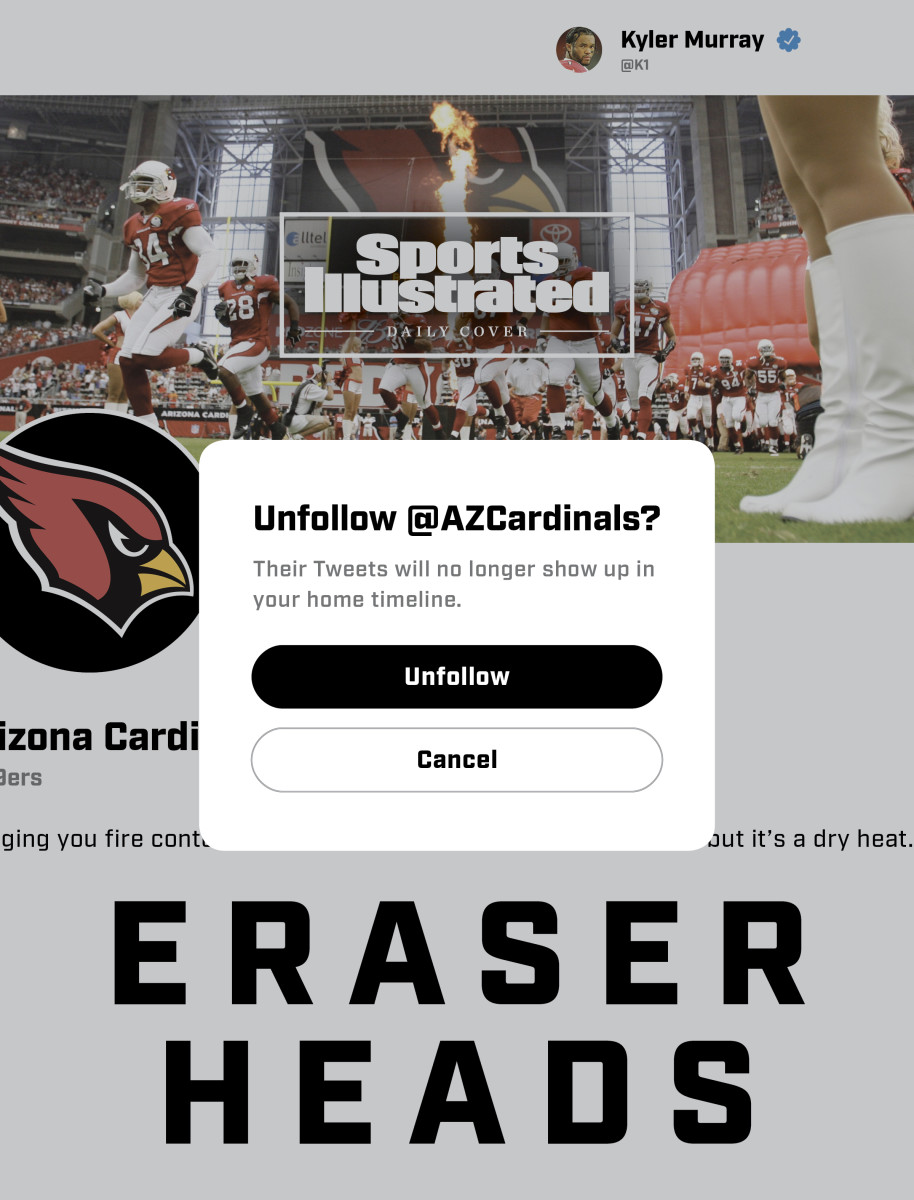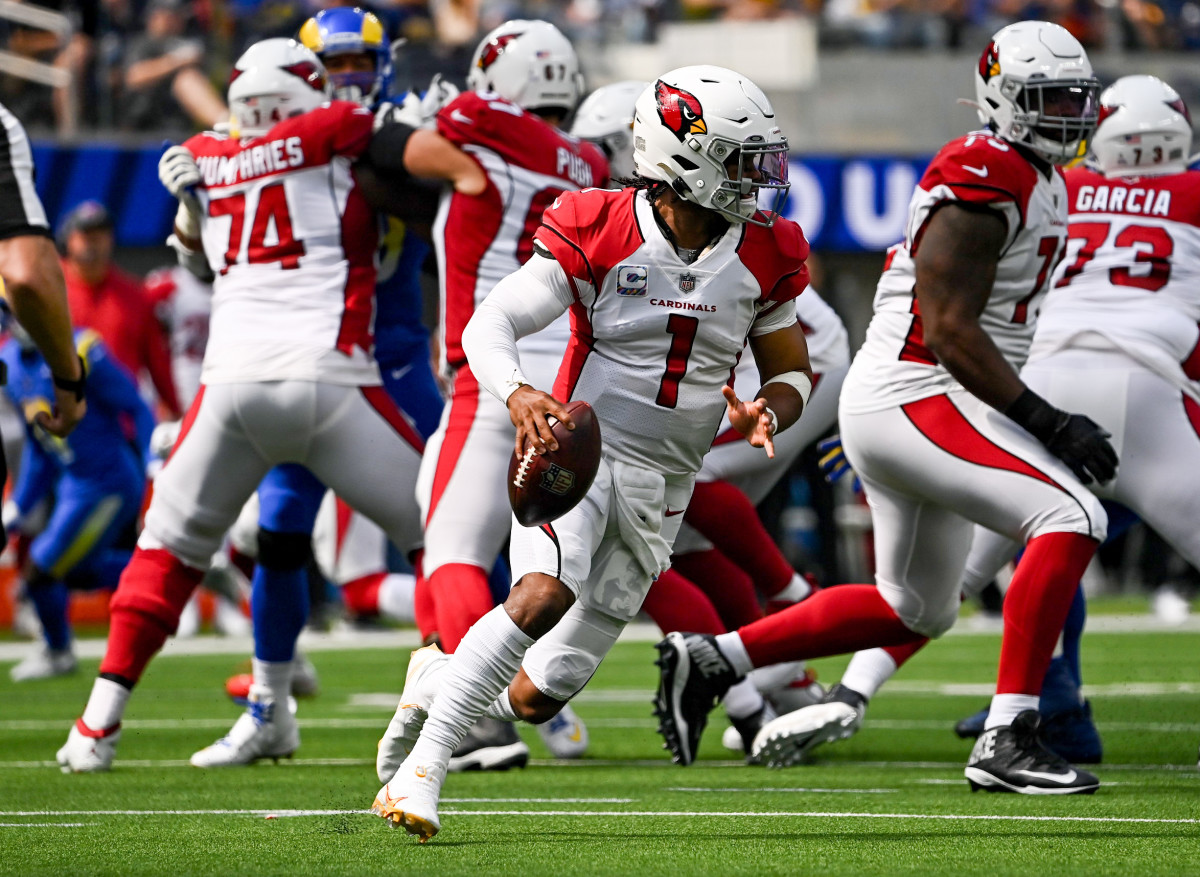Edit. Erase. Dissociate. Understanding the Art of the Unfollow.

Part of what makes Kyler Murray a great football player is that nobody knows what he will do at any given moment. He might throw an 80-yard pass. He might rip off a 50-yard run. But when the Cardinals’ QB was frustrated with his contract this offseason, he made one of the most predictable moves in the modern NFL: He deleted any reference to his team from his social media accounts. (Deebo Samuel did the same thing with the 49ers this spring, as others have done before him.)
Murray’s brief career has now come full (social) circle. When Arizona drafted him to replace Josh Rosen, Rosen unfollowed the team, too.
If the last decade has taught us anything about pro sports, it’s that no matter how big your yacht is, you’re going to sit on the deck, look at your phone and stew about people you can’t stand anymore. In 2017, PSG stars Neymar and Edinson Cavani were supposedly feuding over who would take penalty kicks when Neymar unfollowed Cavani on Instagram. One of the first signs that Antonio Brown’s Raiders tenure was doomed was when he unfollowed quarterback Derek Carr on Instagram. On Dwight Howard’s way from the Lakers to the Rockets in ’13, Kobe Bryant unfollowed him on Twitter.

The unfollow has become such a common move that athletes even joke about it. When Seahawks free safety Quandre Diggs was ejected from a game last September, teammate Jamal Adams told reporters, “If he is ejected again, I’m going to delete his number and unfollow him on Instagram and Twitter. … If he leaves us out there to dry again, we’re going to have problems.”
Astute fans and reporters have learned that to know where an athlete’s heart is, you must watch what his thumbs do. Sometimes we overreact; in 2016, LeBron James unfollowed the Cavaliers, leading to speculation that he would leave the team. Which he did, but not for another two years. But more often, social media is where athletes call their shots. Last summer, Dolphins cornerback Xavien Howard wrote in an Instagram story: “They won’t realize how big a part you play … until you not there to play it no mo.” Two weeks later, he requested a trade.
Some posts are just screeds, or fits of annoyance. When an athlete unfollows his team, however, the intentions are unspoken but almost always clear.
The unfollow-as-negotiating-tactic is—for now, at least—almost exclusively the province of NFL players, because they are the ones who need it. Pro football contracts are rarely fully guaranteed, and players are perpetually worried about career-ending or career-limiting injuries. Compared to most sports, NFL contracts are far more likely to be renegotiated before they expire.
For decades, an NFL star who wanted a new deal would hold out during training camp. The idea was that, eventually, his team would miss him enough to sign a deal. What worked for Cowboys running back Emmitt Smith in 1993 worked for one of his successors, Ezekiel Elliott, in 2019.
But the current collective bargaining agreement, signed in 2020, includes such stiff financial penalties for missing camp that veteran holdouts are no longer an attractive option. (Rookie holdouts—before a player has signed with a team—fall in a different category.) Today’s players need other means to pressure teams.

The social media scrub is passive-aggressive but targeted. A player complaining about his contract might look greedy. But a player deleting any connection to his franchise from his social media just looks mad. Yes, he’s often mad because he wants to get paid more, but the message to the public is the team has damaged its relationship with a star—and that looks bad for the team.
As one agent explained to Sports Illustrated, there can be subtle benefits to social media scrubbing. During negotiations, a team may sometimes perceive that the agent is taking a harder line than their client would like and sense weakness. A social media scrub shows the player and the agent are in lockstep.
There is a potential downside, of course. The player could look petty. Fans could turn against him. But compared to, say, holding a press conference to demand a new contract, a social media scrub is fairly low risk.
It also gives the player plausible deniability. Even though Murray scrubbed his accounts in the leadup to the Cardinals apparently leaking concerns about his maturity to ESPN and the NFL Network, and shortly before his agent, Erik Burkhardt, put the Cardinals on blast by demanding a new contract, Murray claimed at a charity event that his scrub “had nothing to do with the Cardinals.”
Well, somebody will believe that. But if Murray was mad at the Cardinals, as most assume, the way he expressed his ire is relatable.
Over the first five years of his career, Murray is slated to earn more than $65 million from Arizona. In the NFL marketplace, his services are worth more than that. Most of us cannot relate to somebody making $65 million and feeling underpaid, but we can relate to hurt feelings and wanting some distance.
The obvious comparison is to the end of an intimate relationship: “When you break up with an ex-boyfriend or ex-girlfriend, we delete, we react,” says Ishveen Jolly, founder and CEO of OpenSponsorship, which pairs athletes with sponsors who want to capitalize on athletes’ social media followings. When Aaron Rodgers and Danica Patrick broke up, Patrick unfollowed him on Instagram. Jennifer Lopez unfollowed Alex Rodriguez after she left him.
But the better comparison is professional. As Jolly posits: “He is employed by a company. He is a little bit unhappy with them. If one of our team was unhappy with me, I doubt they would be [airing all their grievances] on LinkedIn.”
Annoying your best employees is bad business, which is why the best-run NFL franchises generally do not end up dealing with these social media blowups. When the Chiefs reached an impasse with Tyreek Hill, they traded him before it got ugly online. When Aaron Donald wanted a new deal from the Rams, he talked publicly about retiring but never distanced himself from the team. In a way, it’s surprising that Donald didn’t use social media as leverage. After all, he had just signed a marketing deal with Kanye West’s firm, Donda Sports. Last fall, as things got messy in their relationship, Kanye unfollowed his ex, Kim Kardashian, on Instagram. Then he refollowed her. Then, after she started dating Pete Davidson, Ye unfollowed her again.
More SI Daily Cover Stories:
• ‘Oh, You Look Like the Rock’: Finding Rocky’s Family
• Kelly Slater Won the Super Bowl of Surfing at 50. So, What’s Next?
• NBA Draft? Nah. He’s Following the Money, Right Back to School.
